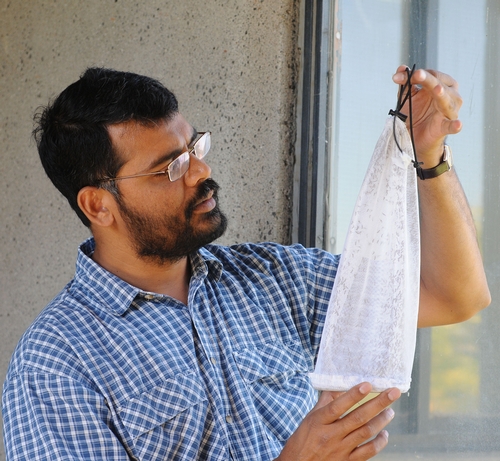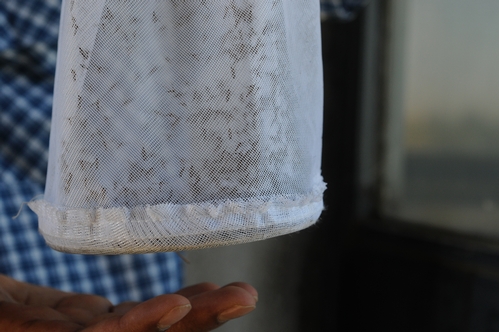- Author: Kathy Keatley Garvey
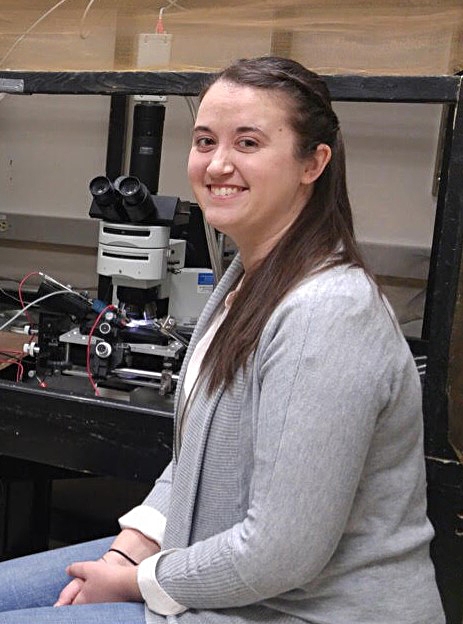
If you're a postdoctoral researcher, it's not every day you get to present your work at an international symposium.
And it's not every day that a veteran professor seeks out "rising stars" to participate in that international symposium.
Congrats to postdoctoral researcher Amber Crowley-Gall of the UC Davis Department of Entomology and Nematology, selected as one of the rising stars featured in an international symposium on “The Frontiers in Chemical Ecology,” part of the Aug. 8-12 joint meeting of the International Society of Chemical Ecology (ISCE) and the Asia-Pacific Association of Chemical Ecologists (APACE) in Kuala Lumpur, Malaysia.
Crowley-Gall, a two-year USDA-NIFA (U.S. Department of Agriculture/National Institute of Food and Agriculture) postdoctoral fellow in the laboratory of associate professor and community ecologist Rachel Vannette, will present "Olfactory Variation Among Closely Related Cactophilic Drosophila Species," a collaborative project with her doctoral dissertation advisor, Professor Stephanie Rollmann of the University of Cincinnati.
“I am very excited about the opportunity to participate in this symposium,” said Crowley-Gall, who holds a doctorate in biological sciences from the University of Cincinnati (2019), and a bachelor's degree in biological sciences, magna cum laude, from Wright State University (2012).
UC Davis distinguished professor Walter Leal of the Department of Molecular and Cellular Biology and a former chair of the UC Davis Department of Entomology, is organizing and producing the hybrid (in-person and virtual) symposium.

Others to be spotlighted in the Frontiers symposium: postdoctoral fellows Rick Fandino of Cornell University and Ani Agnihotri of Murdoch University; soon-to-be-assistant professor Dan Peach of the University of Georgia; associate professors Mengbo Guo of the Chinese Academy of Agricultural Sciences, Zain Syed of the University of Kentucky (formerly of the Walter Leal lab, UC Davis) and Karen Menuz of the University of Connecticut; and professor Chen-Zhu Wang, of the Chinese Academy Sciences.
"I am grateful for this opportunity to present my research and network with other chemical ecologists around the world," said postdoctoral scholar Rick Fandino, a research associate at Cornell University's Department of Ecology and Evolution. "As a first-generation U.S. American Latinx these opportunities are critical to advance in highly competitive and underrepresented STEM fields."
“It's incredibly supportive of Walter to use his standing in the field to help elevate early career researchers," said selected participant Greg Pask, an assistant professor of biology, Middlebury College, Vermont. "And I'm excited to hear about the exciting research from this generation of chemical ecologists.” (For more on the invited speakers, access this short video at https://youtu.be/liy9HpKTmOo)
Managing Sustainability in Challenging Times. The ISCE-APACE joint meeting, themed “Managing Sustainability in Challenging Times,” will include 15 plenary, 15 symposia, as well as invited lectures. Among the lectures is the inaugural Wittko Francke Daaks-Chemicals Memorial Lecture, sponsored by Wittko Francke's Daaks-Chemicals Fund. ISCE promotes the understanding of interactions between organisms and their environment that are mediated by naturally occurring chemicals.
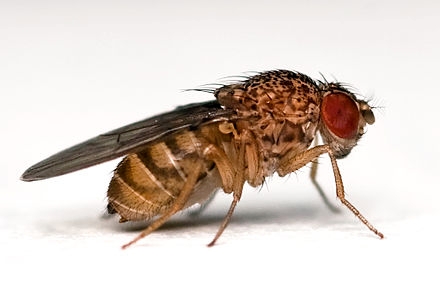
"Chemical cues are important for a wide range of tasks such as host plant identification and localization, oviposition site selection, and mate recognition," she explains in the abstract of the paper, co-authored by Stephanie Rollmann, John Layne, Aaron Hamrick, Lucinda Lawson, all of the Department of Biological Sciences, University of Cincinnnati. "Insects use volatile cues emitted from plants when navigating toward an appropriate host and divergence in odor detection has been shown to result in shifts in host use between populations and in some cases reproductive isolation between populations and eventual speciation. A comparative phylogenetic approach can determine whether variation in the olfactory system is linked to shifts in host plant use and is a means to determine the influence of olfactory tuning on divergence between species.
Useful Model. "A useful model to examine this is the Drosophila repleta species group, a radiation of flies specializing on cacti, that exhibits three types of host use: 1) Opuntia specialists, 2) columnar specialists, and 3) “generalists” on both. Opuntia, a flat leaf cactus, is hypothesized to be the ancestral host, and the use of the more chemically complex columnar cactus is believed to be an acquired trait. Columnar cacti contain elevated levels of secondary compounds that can be toxic to flies and affect the volatile headspace flies are exposed to when choosing a suitable host plant. This study examined the extent to which odor tuning has diverged along with the repeated shifts in host plants within the Drosophila repleta species group. We characterized odor response profiles from select sensillar subtypes across multiple species within the repletagroup as well as the outgroup D. melanogaster. Variation in both sensitivity and specificity to odors was observed, with some ORNs exhibiting variation associated with host cactus use. This study is the first in-depth analysis of the olfactory system across the repleta group and provides the opportunity to test for conserved mechanisms in the olfactory system underlying divergence and host shift."
Leal, widely known for his research, teaching, mentoring and public service, won the 2022 Academic Senate's Distinguished Scholarly Public Service Award for his outstanding series of webinars educating the public about COVID-19. His four online or virtual symposiums drew more than 6000 viewers from 35 countries. And just recently, he was named the UC Davis College of Biological Science's Faculty Teaching Award.
Leal is an elected Fellow of the National Academy of Inventors, American Association for the Advancement of Science, California Academy of Sciences, Royal Entomological Society and the Entomological Society of America (ESA). The UC Davis Academic Senate named him the recipient of its 2020 Distinguished Teaching Award for Undergraduate Teaching, and the Pacific Branch of ESA presented him with its 2020 Award of Excellent in Teaching.
The public can sign up for the free-access webinar, sponsored by Bedoukian Research, Inc., here: https://bit.ly/3PeXJhu

- Author: Kathy Keatley Garvey
Researchers in the Walter Leal lab, UC Davis Department of Entomology, are engaging in some exciting research.
They just discovered a "generic insect repellent detector" in the fruit fly (Drosophila melanogaster)--research published today (March 16) in PloS One (Public Library of Science).
What's exciting is that this research may lead to more effective and lower-cost products than DEET, the gold standard of insect repellents.
The five-member team found the sensory organs involved when fruit flies detect and avoid three key insect repellents: DEET, IR3535 and picaridin. They identified the olfactory receptor neuron (ORN) and characterized its receptor, DmOr42a.
The research team of Leal; primary author and chemical ecologist Zain Syed; chemical ecologist Julien Pelletier; and undergraduate students Eric Flounders and Rodrigo Chitolina, first found that the fruit fly avoids all three well-known repellents, DEET, IR3535 (a compound known as Avon Corporation’s “Skin-So-Soft Bug Guard”) and picaridin (derived from pepper) and then set out to find olfactory receptor neurons sensitive to those insect repellents. They scanned all olfactory sensilla in the antennae and the mouthpart structure, maxillary palps, using single unit electrophysiological recordings.
The receptor they found “fulfills the requirements for a simplified bioassay for early screening of test insect repellents,” they wrote in the scientific paper.
When you think that it takes about 10 years and $30 million to develop a new repellent--and only one test compound in 20,000 reaches the market--this could really speed up the process.
Zain Syed told us: "In this study, by using established behavioral assays to dissect the mechanism of repulsion in fruit flies, we demonstrated for the first time that Drosophila equally avoid other repellents--picaridin and IR3535. By challenging every type of olfactory sensilla on the antenna and maxillary palps, we identified neurons and then the odorant receptor that detect these repellents."
The UC Davis research, as Syed said, "adds a new dimension in research towards understanding the molecular, cellular and organismal response to repellents."
Chemical ecologist Coby Schal, the Blanton J. Whitmire Distinguished Professor of Entomology at North Carolina State University, praised the research as “an excellent example of translational research that can lead to a streamlined and less expensive path of discovery of new repellents.”
In earlier research, Syed and Leal identified a DEET-sensitive olfactory receptor neuron in the Southern House mosquito. “Going from the neuron to the receptor, however, is like looking for the proverbial needle in a haystack as the mosquito genome has some 181 olfactory receptor genes,” Schal said.
The Leal lab knows DEET. Back in August 2008, Leal and Syed drew international attention when they announced they'd discovered DEET’s mode of action or how it works. Scientists long surmised that DEET masks the smell of the host, or jams or corrupts the insect’s senses, interfering with its ability to locate a host. The Leal-Syed research showed that mosquitoes actually smell DEET and avoid it because they dislike the smell.
DEET, developed by scientists at the U.S. Department of Agriculture and patented by the U.S. Army in 1946, is the go-to insect repellent. Worldwide, more than 200 million use DEET to ward off vectorborne diseases.
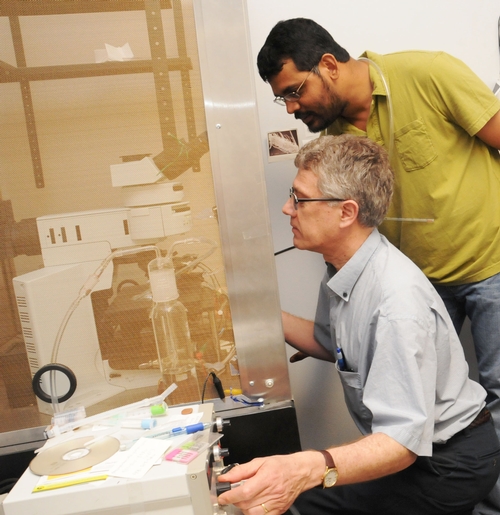
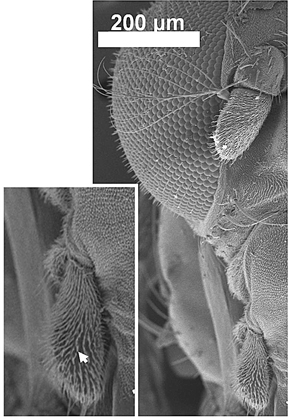
- Author: Kathy Keatley Garvey
The female silkworm moth releases a sex pheromone, bombykol, that's very enticing to the male. He can detect it from miles away.
Now researchers in the UC Davis Department of Entomology have discovered that the fruit fly has a native odorant receptor that detects the silkworm moth’s sex pheromone, and that it’s “amazingly more sensitive” than the moth’s odorant receptor.
Their work could open research doors for insect-inspired biosensors.
Walter Leal, professor of entomology, and postdoctoral scholar Zain Syed know the olfactory systems of silkworm moths (Bombyx mori) and fruit flies (Drosophilia melanogaster) well.
In a serendipitous discovery, the chemical ecologists found that the fruit fly’s odor detector not only detects bombykol, but responds to bombykol with high sensitivity. Their groundbreaking research, Bombykol Receptors in the Silkworm Moth and the Fruit Fly, was published May 3 in the Proceedings of the National Academy of Science (PNAS).Their research follows on the heels of another study they published in PNAS in 2006 with the Deborah Kimbrell genetics lab in the UC Davis College of Biological Sciences. Bottom line: they found that genetically engineered fruit flies responded to the silkworm moth scent of a female.
Now Leal and Syed have identified the odorant receptor in the male fruit fly that detects the sex pheromone.
Ecologist and evolutionary biologist Fred Gould of North Carolina State University, not affiliated with the research, says the work of the UC Davis researchers "provides important guidance and tools for other researchers who want to explore the pheromone communication systems of other species, or who want to further dissect the mechanisms within the specialized hairs of silkworms that enable this high sensitivity.”What we have here with the silkworm moths and fruit flies is definitely not a "failure to communicate."
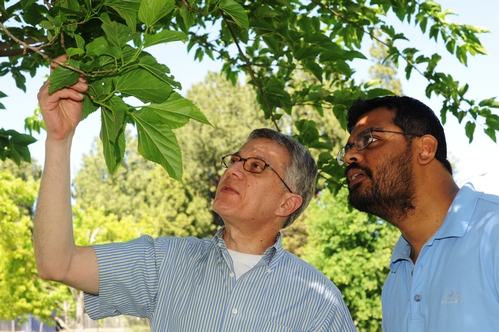
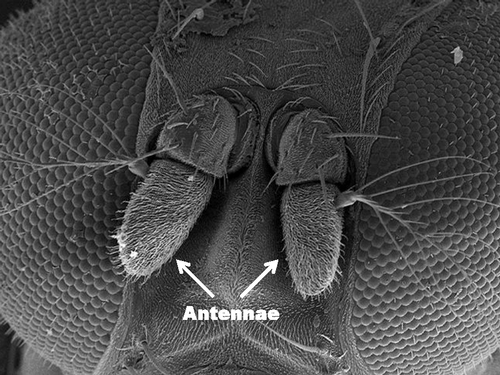
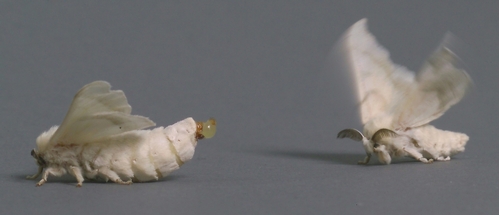
- Author: Kathy Keatley Garvey
Chemical ecologist Walter Leal, professor and former chair of the UC Davis Department of Entomology, and his postdoctoral researcher Zain Syed have done it again.
In August of 2008, they discovered the secret mode of the insect repellent, DEET. In groundbreaking research published in the Proceedings of the National Academy of Sciences (PNAS), they found that DEET doesn't mask the smell of the host (that would be you and me), nor does DEET jam the insect's senses.
Mosquitoes CAN indeed smell DEET. They avoid it because they don't like the odor.
Then on Monday, Leal and Syed published more groundbreaking research, also in PNAS. They identified the dominant compound that attracts Culex mosquitoes to both birds and humans.
It's a compound called nonanal, naturally produced in birds and humans. This not only explains the host shift from birds to humans, but paves the way for key developments in mosquito and disease control.
Infected Culex mosquitoes transmit life-threatening diseases, including West Nile virus. Since 1999, the Centers for Disease Control and Prevention has recorded 29,397 human cases and 1,147 fatalities in the United States alone.
“Nonanal is how they find us,” Leal said. “The antennae of the Culex quinquefasciatus are highly developed to detect even extremely low concentrations of nonanal.”
Researchers from throughout the country this week praised their work.
Yale University professor John Carlson, a leading scientist in insect olfaction, described the study as “exciting with important implications for the intriguing question of how mosquitoes find the humans they bite.”
“Leal and Syed have identified a human odor that is detected with great sensitivity by the antennae of mosquitoes that transmit West Nile virus,” Carlson said. “In addition to its scientific interest, the study may have important practical applications in the control of these mosquitoes and the diseases they carry.”
Chemical ecologist Coby Schal, a professor at North Carolina State University, described the research as representing “some of the best research on insect olfaction that I have ever read. By combining trapping experiments in the field with careful characterization of the response profiles of antennal and maxillary sensilla of Culex mosquitoes, Syed and Leal show not only that the combination of carbon dioxide and nonanal is an important beacon for blood-seeking mosquitoes, but also that a large fraction of the sensilla on the mosquito’s nose (antennae) is dedicated to the detection of nonanal at incredibly low concentration.
“Such high sensitivity of olfactory receptor neurons to nonanal – rivaling the response characteristics of pheromone responsive neurons – suggests that nonanal has played an important role in the evolution of host-finding and host-preferences in Culex mosquitoes,” Schal said. “This is a truly exceptional achievement by the outstanding Syed/Leal team, but in step with their previous outstanding contributions on a wide range of arthropods.”
More information on the Leal lab research is on the Department of Entomology Web page.
Leal, a newly elected Fellow of the Entomological Society of America (he's one of 10 entomologists to be so honored this year) and Syed, named one of the top post-doctoral researchers at UC Davis this year, have indeed done it again.
When you think of all the havoc that mosquito-borne diseases have wreaked, this is the kind of research that definitely deserves a round of applause.
Dr. Leal and Dr. Syed are a highly efficient and effective SWAT team.
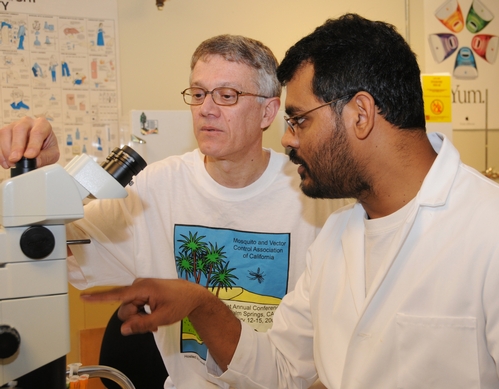
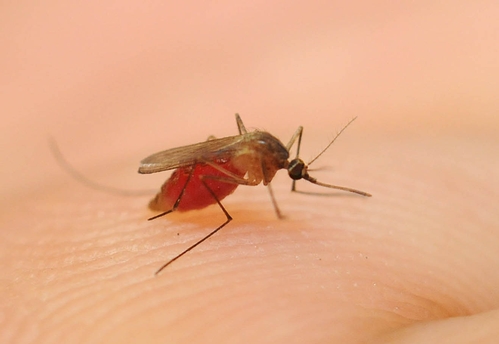
- Author: Kathy Keatley Garvey
Chemical ecologist Zain Syed of the Walter Leal lab, University of California, Davis, knows just where to find mosquitoes for his research.
Rice fields.
He's been collecting up to 3000 mosquitoes a night along the Yolo Causeway, located on Interstate 80 between Davis and West Sacramento. The Yolo basin is home to the Vic Fazio Yolo Wildlife Area.
It's easy to catch mosquitoes.Syed is using carbon-dioxide traps to capture host-seeking mosquitoes. The female skeeters are seeking a blood meal (you, if you're around there). His traps entice them to "come on in."
"Once mosquitoes are lured to the vicinity," Syed says, "a suction fan traps them and sends them to the sleeve, a mesh bag that holds mosquitoes."
The mesh bag below holds 2000 mosquitoes. They are mostly Culex tarsalis, but also some Culex pipiens.
Culex mosquitoes are known for transmitting West Nile virus.
Syed and Leal are known for uncovering the mode of action for DEET, the chemical insect repellent used by more than 200 million people worldwide. Their groundbreaking research last year found that DEET doesn't jam a mosquito's senses or mask the smell of the host, as scientists previously thought for some 50 years. Mosquitoes avoid DEET because it smells bad to them.
Syed recently won one of two coveted campuswide awards for excellence in postdoctoral research from a field of 800 postdocs.
But other fields--rice fields--have always drawn his attention.
That's where the skeeters are.
